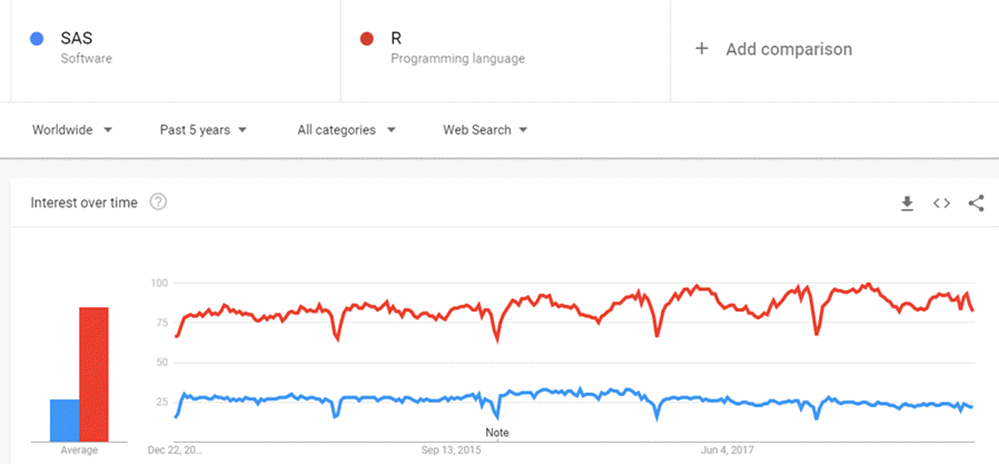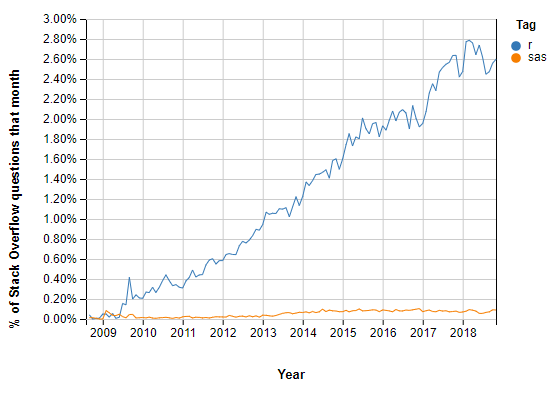What is SAS?
SAS stands for S tatistical A nalysis S oftware which is used for Data Analytics. It helps you to use qualitative techniques and processes which allows you to enhance employee productivity and business profits. SAS is pronounced as SaaS.
In SAS, data is extracted & categorized which helps you to identify and analyze data patterns. It is a software suite which allows you to perform advanced analysis, Business Intelligence, Predictive Analysis, data management to operate effectively in the competitive & changing business conditions. Moreover, SAS is platform independent which means you can run SAS on any operating system either Linux or Windows.
What is mean by R?
R is a programming language is widely used by data scientists and major corporations like Google, Airbnb, Facebook etc. for data analysis.
R language offers a wide range of functions for every data manipulation, statistical model, or chart which is needed by the data analyst. R offers inbuilt mechanisms for organizing data, running calculations on the given information and creating graphical representations of that data sets.
Learn Java Programming with Beginners Tutorial
Google Trend SAS vs R
Why use SAS?
- Access raw data files and data in external database
- Analyze data using statics, descriptive, multivariate techniques, forecasting, modeling, and linear programming
- Helps you to manage data entry, formatting, conversion, editing & retrieval
- Advanced analytics feature allows you to make changes and improvements in business practices
- Helps businesses to know about their historical data
Why use R?
- R offers a useful programming constructs for data analytics like conditionals, loops, input and output facilities, user-defined recursive functions, etc.
- R has a rich and expanding ecosystem and plenty of documentation available over the internet
- You can run this tool on a variety of platforms including Windows, Unix, and MacOS
- Good graphics capabilities Supported by an extensive user network
R Vs Sas Stackoverflow Questions
History of SAS
- SAS was developed by Jim Goodnight and John Shall in 1970 at N.C. University
- Initially, it was developed for Agricultural Research.
- Later, it expanded to a gamut of tools to include Predictive Analytics, Data Management, BI among others.
- Today 98 of world’s top companies in fortune 400 uses SAS data analytical tool for Data analysis.
History of R
- 1993- R is a programming language developed by Ross Ihaka and Robert Gentleman
- 1995: R first distributed as an open-source tool under GPL2 license
- 1997: R core group and CRAN founded
- 1999: The R website, r-project.org, launched
- 2000: R 1.0.0 released
- 2004: R 2.0.0 released
- 2009: First edition of the R Journal
- 2013: R 3.0.0 released
- 2016: New R logo adopted
SAS Vs. R
| Parameters | SAS | R |
|---|---|---|
| Availability / Cost | SAS is commercial software, so it needs a financial investment. | R is open source software, So, anyone can use it. |
| Ease of Learning | SAS is the easiest tools to learn. So, people with limited knowledge of SQL can learn it easily. | R programmers need to write tedious and lengthy codes. |
| Statistical Abilities | SAS offers a powerful package which offers all types of statistical analysis and techniques. | R is an open source tool which allows users to submit their own packages/libraries. The latest technologies are often released in R first. |
| File Sharing | You can’t share SAS generated files with another user who does not use SAS. | Since anyone uses r, it is much easier to share files with another user. |
| Updates | SAS relatively less frequently updated. | R is an open source tool, so it is continuously updated. |
| Market Share | Currently, SAS is facing stiff competition from R, and other Data analytical tool as a result market share of SAS is gradually declining. | R has seen exponential growth in the last past five years with its increasing popularity. That is why its market share is increasing rapidly. |
| Graphical Capabilities | SAS has good graphical support. However, it does not offer any customization. | Graphical support of R tool is poor. |
| Customer Support | SAS provides dedicated customer support. | R has the biggest online communities but no customer service support. |
| Support for Deep learning | Deep Learning in SAS is still in its early stages, and there’s a lot to work for before it matures. | R offers advanced deep learning integrations. |
| Job Scenario | SAS analytic tool is still the market leader as far as corporate jobs are concerned. Many big companies still work on SAS. | Jobs on R have been reported to increase over the last few years. |
| Salary Range | The average salary for any SAS programmer is $81,560 per year in the U.S.A. | The average salary for “R” programmer" ranges from approximately $127,937 per year for Data Scientist to $147,189 per year. |
| Best features | * Variables |
- Mixins
- Nested rules
- Maintainable
- Functions|* Data analysis
- Graphics and data Flexible statistical analysis
- Highly interactive|
|Famous companies using|Airbnb, StacShare, Asana, Hubspot|Instacart, Adroll, Opbandit, Custora|
|TIOBE Rating|22|16|
Feature of R
- R helps you to connect to many databases and data types
- A large number of algorithms and packages for statistics flexible
- Offers effective data handling and storage facility
- Collect and analyze social media data
- Train machines to make predictions
- Scrape data from websites
- A comprehensive and integrated collection of intermediate tools for data analysis
- Interface with other languages and scripting capabilities
- Flexible, extensible and comprehensive for productivity
- Ideal platform for data visualization
Features of SAS
- Operations Research and project Management
- Report formation with standard graphics
- Data updating and modification
- Powerful Data handling language
- Read and write almost any data format
- Best data cleansing functions
- Allows you to Interact with multiple host systems
The Final Verdict
After comparing some main differences between both these tools, we can say that both have their own set of users. There are many companies, who prefer SAS because of data security issues, which show despite a drop in a recent year, there is still a huge demand for SAS certified professionals.
On the other hand, R is an ideal tool for those professionals who want to do deep cost-effective Data analytics job. Numbers of startup companies are increasing all over the world. Therefore, the demand for R certified developers are also increasing. Currently, both have the equal potential for growth in the market, and both are equally popular tools.


